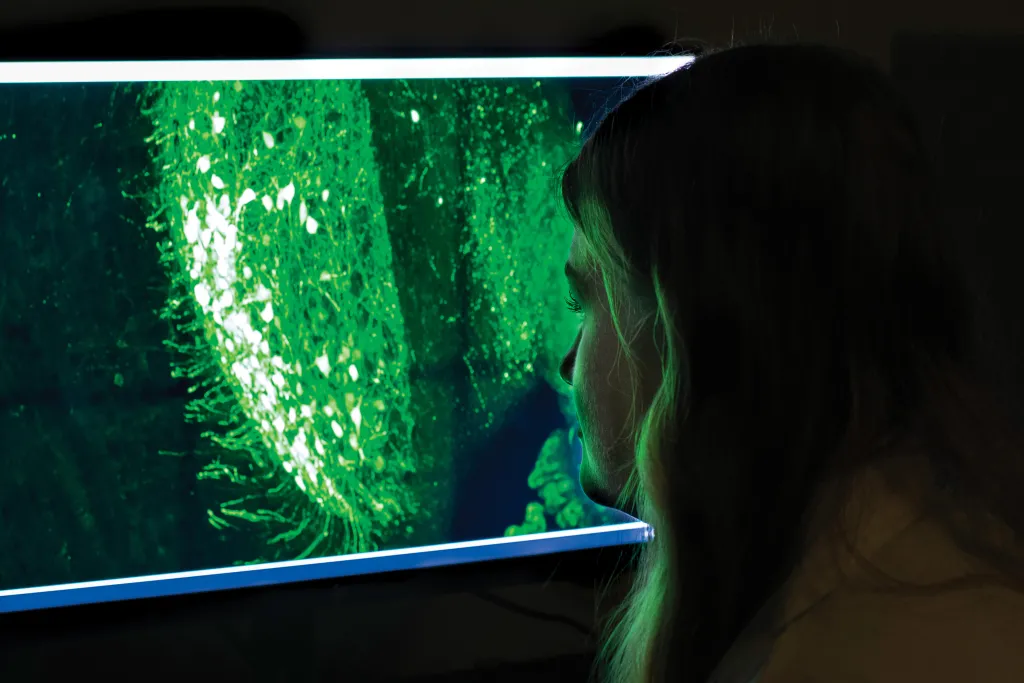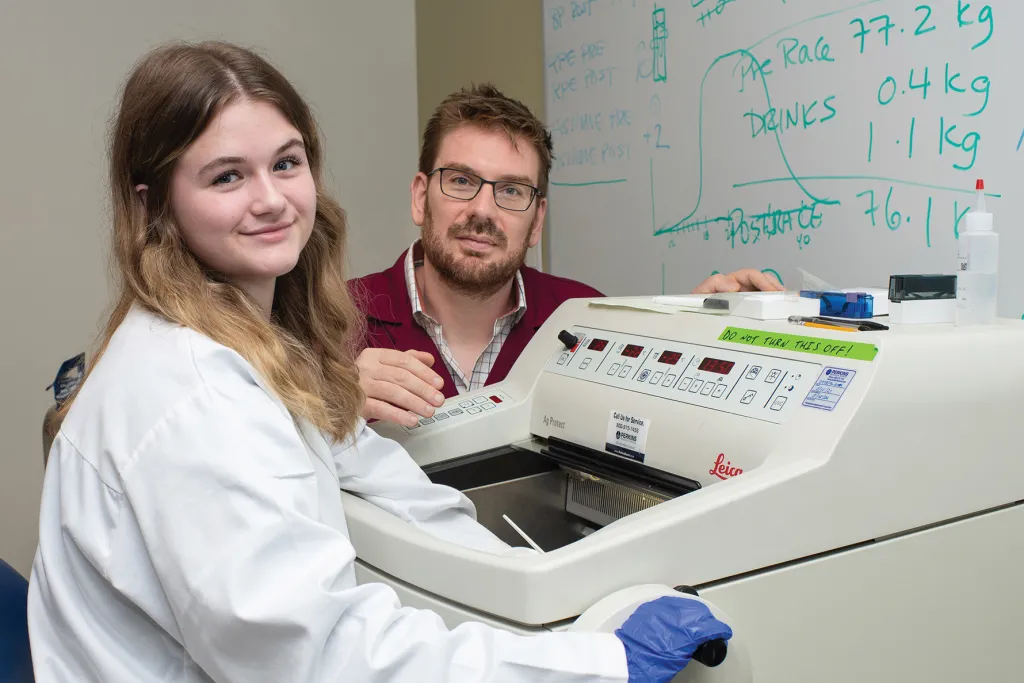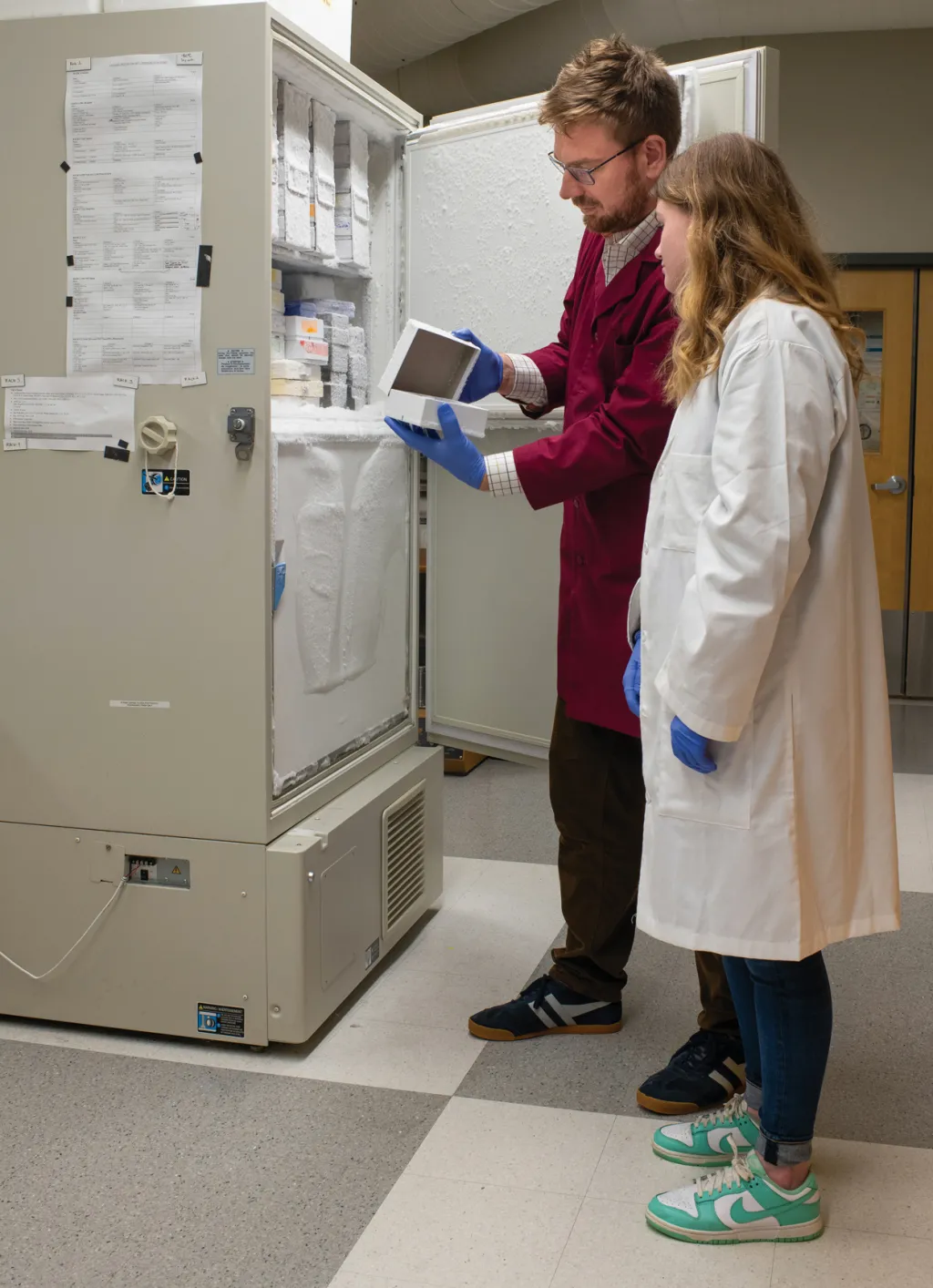One Slide at a Time: UNE Undergrad Joins the Enduring Quest to Cure Alzheimer’s
by Zach Brockhouse
Deep within the Pickus Center for Biomedical Research, Jayden Lovely (Medical Biology, ’26) points to a cluttered desk surrounded by vial-filled shelves. “A lot of my research is done right here,” she said. Set against the trees on UNE’s campus in Biddeford, the research building houses some of the University’s most innovative biomedical research. It is here that Lovely, a rising sophomore, is conducting research with tangible implications for Alzheimer’s disease.
In another room, she uses a machine called a cryostat to slice a sample and stain it to highlight the focus of her research, the CD2AP protein. She examines the results in UNE’s new Olympus Slide Viewer. “I look for the differences and record them,” she said. “If all goes as planned, I could be contributing directly to a major breakthrough in the treatment of Alzheimer’s.”

Lovely is pursuing the pre-physician assistant (PA) track within UNE’s medical biology bachelor’s degree program, which equips students with the skills necessary to pursue graduate physician assistant studies after graduation. For her, the state’s only PA program suits her desire to follow many interests while not being held to the same timeline of a medical degree. She found her niche as a member of the Pre-Physician’s Assistant Club, but felt she still wanted more.
When a member of the club mentioned that there were research opportunities available to students, Lovely perked up. It was exactly what she had been looking for. She quickly sent off an email stating her interest and was paired with Madison Meuth, a doctoral student from the University of Maine in the laboratory of Benjamin Harrison, Ph.D., assistant professor of biochemistry and nutrition at UNE, who studies how pain signals are received by the body.
Lovely quickly found herself immersed in Harrison’s lab working on a real-world research project with real-world applications.


A Budding Researcher Learns the Ropes
Lovely’s initial lab work wasn’t even related to Alzheimer’s. It was about pain.
In 2022, Harrison received $1.8 million in funding from the National Institute of Neurological Disorders and Stroke, a division of the National Institutes of Health, to explore non-opioid treatments for chronic pain at the cellular level. He is using the five-year grant to study how to reduce the electrical firings in nociceptors, which are neurons that transmit pain signals in response to painful injuries. His focus is searching for non-narcotic ways to block how pain is processed in our bodies.
Harrison and his team have discovered that nociceptors contain a protein called “CELF4,” an RNA binding protein they theorize inhibits the production of “pro-nociceptive,” or pro-pain-sensing cellular components. In essence, they are trying to trick the proteins to limit pain signals. His research focuses on delivering CELF4 into pain neurons, where the protein will limit the synthesis of ion channels, receptors, and other molecules that sensitize them.
“The work Dr. Harrison had done was astounding — and intimidating. At first, I wasn’t sure of myself. I’d attended lab meetings before, but hearing the lingo and seeing the tools used in this environment seemed completely different,” Lovely said.
“I’m on a journey here at UNE, and it’s all part of the process,” she added. “There is so much that goes into a research project. And there is so much knowledge around from the people I get to work with. It’s taking me a while to wrap my head around everything, but I learn something new every time I walk into the lab.” Working with Meuth, Lovely began to learn histology, the study of the microscopic structure of tissues. Together, they aided Harrison with his research, specifically, to study if a locally administered adeno-associated virus can stimulate the production of CELF4 and reduce pain in those areas — an approach known as gene vector therapy.
“Using this novel gene vector therapy approach, we can develop pain therapies that carry fewer risks than conventional opioid medications, such as addiction,” Harrison remarked.
“This research could prove beneficial for those living with chronic pain but who do not want to undergo surgeries — which can be expensive and leave people with no sensation at all,” Lovely added.
Federal Research Powerhouse Unlocks New Funds
The leap from pain research to Alzheimer’s took place when Harrison learned about a new research initiative at the Jackson Lab, a nonprofit biomedical research institution in Bar Harbor, several hours north of UNE’s Biddeford Campus. That project involved the CD2AP protein and how its variants can lead to Alzheimer’s disease. Seeing the similarities in his research blocking pain signals in proteins, he thought Lovely would be a good fit to research why some proteins actually stop receiving information in Alzheimer’s patients.
“Not many schools allow students the opportunity to get involved at this level, coming here and jumping right in during their freshman year,” Harrison said. “By the time she graduates, Jayden will have a much deeper understanding of the scientific process. Very different than another school.”
Lovely was intrigued. The commonalities between pain and Alzheimer’s research were reassuring, she said. “I felt like I had a good foundation to move forward from,” she said. But there was one problem — funding. She and Harrison began the journey that every great researcher must endure — writing grant applications. Luckily, they were in good company. In 2022, the National Institutes of Health added $264 million in economic activity in Maine with $112.7 million in grants and contracts, according to data provided by the federal government. UNE received seven grants totaling over $4 million — more than any other college or university in Maine.
“Dr. Harrison guided me through every step of the process. It was a little overwhelming, but we got through it and, earlier this year, I learned that our grant had been awarded.” Lovely said, noting that the Kahn Family Foundation paid for her summer housing, provided $1,000 for research materials, and awarded her a small stipend.
Soon, tissue samples were shipped down to Biddeford to the Pickus Center’s 22,000 square feet of state-of-the-art research space, where Lovely could begin her work.
In her project, Lovely is taking a CD2AP variant in mouse brains and comparing them with two normal, “wild-type” brains. Multiple studies have shown an association in changes to the CD2AP gene and the progression of Alzheimer’s. Lovely is setting out to prove that mice with the genetic variant have changes in the CD2AP protein which could be used to model degeneration.
While the research is ongoing, Lovely knows the opportunity to learn the ins-and-outs of research as early as her freshman year has opened her eyes to the world of research and how the next big breakthrough could only be a slide away from being discovered.
“UNE does an amazing job to get the word out about research projects. The lab takes in students all the time,” Lovely said. “There are lots of students on campus who want to be involved. It’s exciting to think about everyone in campus labs who can make a real difference right now. I’m glad to be part of it all.”
